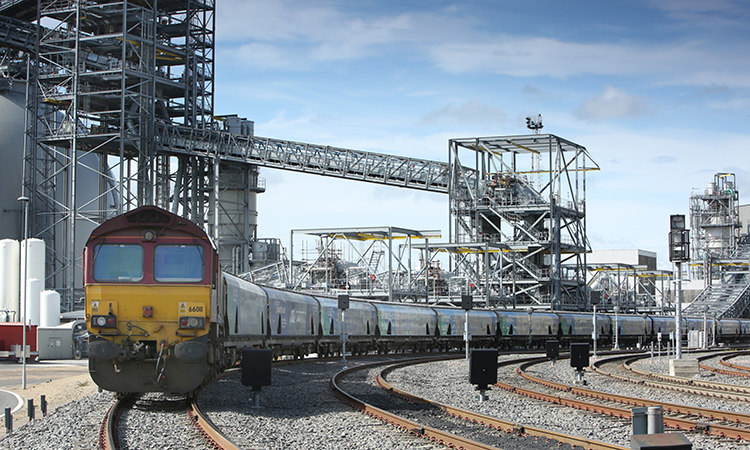Q&A with Andy Bagnall from Rail Partners: Freight expectations
Posted: 21 April 2023 | Elliot Robinson (Editorial Assistant - Global Railway Review) | No comments yet
In this interview, Andy Bagnall, Chief Executive of Rail Partners, discusses the recently released Freight Expectations report and details some of its key findings and the environmental advantages that rail freight possesses.


Credit: Rail Partners
Can you give us an overview of the Freight Expectations report and how it came about?
In the Plan for Rail White Paper published in May 2021, the UK Government committed to setting a rail freight growth target. Since that announcement, Rail Partners and its members have been calling for an ambitious target of trebling freight by 2050, including in our response to the recent call for evidence held by the Great British Railways Transition Team (GBRTT).
Our new report provides the evidence to back up our call to treble freight and highlights the ‘size of the prize’ should government commit to this ambitious target, outlining the substantial economic and environmental benefits that can be realised. The analysis is compelling, estimating that a trebling of freight by 2050 would generate £5.2 billion in annual economic benefits, while removing over 20 million HGV movements from roads every year.
What are the main findings of the report?
Rail freight already provides a critical function within the UK economy today and can do even more tomorrow – with the right support.
One of the core messages of Freight Expectations is the importance of longer, heavier and more direct services. The research shows innovative freight services are now removing up to 129 HGVs from the road network with a single train.
Recent analysis by Deloitte shows that the sector delivered £2.45 billion in economic benefits to UK PLC in 2018/19, with 90% of these benefits occurring outside of London and the South East. The sector supports economic growth across the breadth of Great Britain.
Our report also highlights that rail freight operators continue to improve the environmental credentials of the sector. Customers are increasingly looking to rail freight as a low carbon solution, and we want to see the potential of the sector realised. This is not only in the interest of customers but will also support wider Government priorities of achieving net zero, levelling up the UK economy and supporting British businesses to trade on an international scale. This can only happen if a largely private-sector rail freight industry works in partnership with government, and we have outlined a policy framework in Freight Expectations to support this.
The report shows that a trebling of rail freight is a credible proposition, with analysis based on an extrapolation of existing Network Rail forecasts. To achieve this, rail freight must grow by 4% every year. Annual economic growth over the past 60 years has been 2.25% on average, so if rail freight simply retains its modal share, over half of the growth required to grow treble freight will be achieved, with the remaining growth resulting from modal shift – getting lorries off roads and goods onto the rails.
The case studies in our report show that freight operators are actively exploring opportunities to grow the market. Freight Expectations highlights new international trains transporting cars in and out of the UK, the recent reintroduction of timber traffic in Wales, and new Highland Spring services running in Scotland.
One of the core messages of Freight Expectations is the importance of longer, heavier and more direct services. The research shows innovative freight services are now removing up to 129 HGVs from the road network with a single train – a significant uplift from the previous ‘76’ figure widely used by industry and decision makers alike. Such services are not only beneficial to the customers who use rail freight, but they also improve the carbon efficiency of freight operations. We want to see more of these services introduced.
Ultimately, the report sets out the environmental and economic benefits of growing rail freight and what decision makers need to do to realise them.
Can you explain how this analysis demonstrates rail freight’s environmental advantage over the road haulage sector?
The environmental analysis in our report is based on a direct comparison between rail and road on 16 representative freight flows. Our research team included the University of Hull’s Logistics Institute, who used their Railfreight Energy and Emissions Calculator (REEC) to provide a much more granular understanding of rail freight’s environmental performance.
Overall, the analysis shows that rail has retained its carbon advantage over road freight, with a single tonne of freight moved by rail producing 76% less CO2.
Overall, the analysis shows that rail has retained its carbon advantage over road freight, with a single tonne of freight moved by rail producing 76% less CO2. This is consistent with previous research but demonstrates that rail is keeping pace with other modes in the race to decarbonise freight, largely thanks to productivity improvements made by operators. As highlighted in our report, FOCs are also increasingly using alternative fuels like Hydrotreated Vegetable Oil (HVO) to improve their carbon performance.
The report shows that in future, thanks to its inherent energy efficiency, rail will continue to have a carbon and air quality advantage, even if both rail and road are largely decarbonised. The analysis estimates that rail will produce 81% less particulate matter than road, even if both modes are fully electrified. This reflects the benefit of steel wheels on steel rails leading to lower abrasive emissions compared to rubber tyres on asphalt.
An interesting finding in the report is that the right policy environment would help the rail freight sector to flourish and even support a more prosperous, greener economy in the future. Can you explain what these possible policies are and the ways that they can help the rail freight sector?
First, we want to see the Government commit to an ambitious target to treble rail freight, which would be a catalyst for a transformational approach to the mode, like that which has been seen first-hand in Scotland, where a target was implemented for Control Period 6 (2019-2024). Recently, other European nations including France, Germany and Spain, have also set targets to grow rail freight in recognition of the significant benefits it delivers.
Secondly, the policy framework we set out highlights the importance of a stable access, charging and performance regime. With rail reform legislation on the horizon, it is vital to provide freight operators and customers the necessary confidence to invest. Operators have a proud track record of investment, with over £3 billion committed since privatisation to enhance their offering and grow the market. A growing, greener rail freight sector cannot be achieved without this investment, whether that is in new facilities or the next generation of sustainable freight locomotives and wagons.
To grow rail freight we must make the best use of existing capacity on the network. Our report highlights the benefits being delivered by operators running longer, heavier and more direct services, and further opportunities to expand such services should be explored.
Thirdly, to grow rail freight we must make the best use of existing capacity on the network. Our report highlights the benefits being delivered by operators running longer, heavier and more direct services, and further opportunities to expand such services should be explored.
Freight Expectations highlights a series of infrastructure projects that should be prioritised in order to create additional capacity for freight services to run. Some of these projects have already been committed to, such as HS2 and the Transpennine Route Upgrade, though of course recent news of a further delay to the former was disappointing. Other schemes are vital as well, including the Ely Area Enhancement Scheme, part of the wider Felixstowe to Nuneaton upgrade, which will be critical to growing rail freight not just in the Eastern region, but across the Great British network.
Finally, our report calls for a widening of incentives to position rail freight as the mode of choice for prospective freight customers. The Mode Shift Revenue Support (MSRS) scheme already plays a critical function in the freight sector, with a budget of £20 million per year, the scheme removes 900,000 HGV movements annually, and we are calling for the budget to be doubled when it comes up for renewal in 2025. Our report shows how the Freight Facilities Grant (FFG) in Scotland has supported the development of Highland Spring’s new rail-connected facility, unlocking significant modal shift and we are keen to see the FFG replicated across the whole of the Great British rail network. We’ve also called for further incentives to promote the use of alternative fuels as a stepping stone to the decarbonisation of rail freight.
The report detailed the importance of trebling rail freight by 2050, can you talk more about the benefits that this will offer?
As I’ve touched on already, our analysis, which is based on the Department for Transport’s own Transport Appraisal Guidance (TAG) framework, estimates that a trebling of freight will generate at least £5.2 billion in annual economic benefit every year. This can be broken down into economic, environmental (carbon, air quality, noise) and social benefits (congestion and safety).
If the rail freight market were to treble by 2050, our report shows that over 20 million HGV movements will be removed every year. This is not only beneficial for our environment through carbon reductions and air quality improvements, but it will reduce congestion on the road network, freeing up space for other users and reducing damage to road infrastructure.
We want to see government commit to that target of trebling of freight by 2050, and to putting in place interim milestones to ensure that industry remains on track to deliver this ambitious but achievable target. That is what will ensure the benefits outlined in Freight Expectations can begin to be realised over the course of the next generation.


Related organisations
Deloitte, Department for Transport (DfT), Network Rail, Rail Partners








